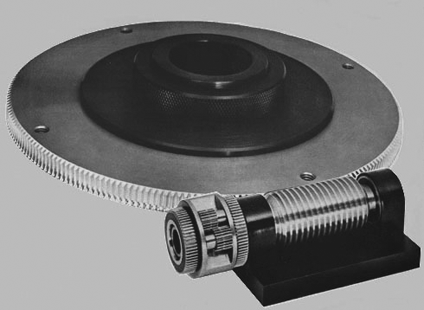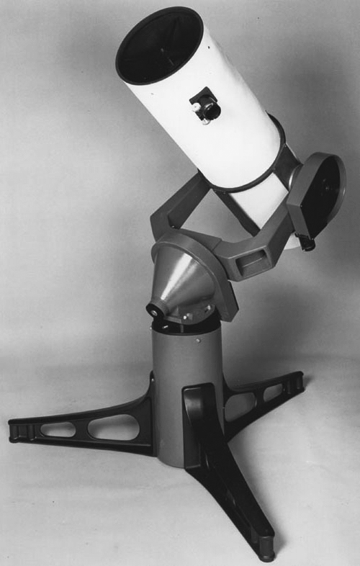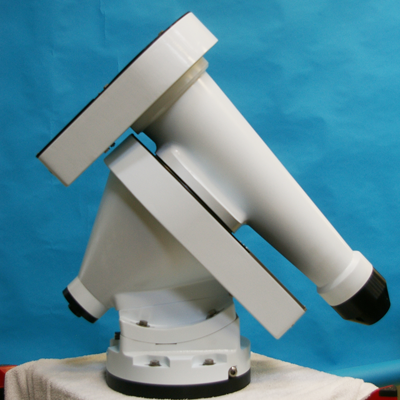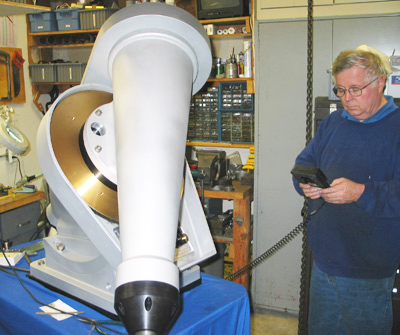
Mathis Instruments currently offers a full line of telescope mountings: the compact MI-500, the versatile MI-750, and the massive MI-1000. With full computer control, each model is available in a German equatorial or an equatorial fork configuration. Our mounts are intended for observatory installation. and they provide the ultimate in precision, performance, and stability.

The MI-500, MI-750, and MI-1000 family of telescope mounts has a long history dating back over 30 years. In 1978, the Thomas Mathis Company began manufacturing custom gear drives for commercial and custom telescope mounts. These worm gear drives were available in diameters of 6 to 24 inches, and they featured custom machined clutches, precision ground worms, matching ball bearing housings, and AC synchronous motors.
In 1982, we designed and manufactured the Model 400 and Model 500 fork mount, suitable for use with the newly available Celestron 11 and Celestron 14 telescopes. These mounts were intended for those wishing to install their Celestron telescope in an observatory. However, our fork mounts soon became popular for use with 12 to 16 inch Cassegrain telescopes, and compact 10 to 14-inch Newtonian telescopes.

The Model 500, predecessor of the MI-500, featured thick-walled aluminum castings, a massive conical polar base, and a rigid box fork arms. It included a 12-inch diameter worm gear drive with an integrated gear differential. The mount used dual motors: a synchronous motor for tracking and a DC motor for slewing. With variable speed motors on each axis, one could slowly slew the telescope across the sky while tracking the stars. Those were the days when computer controlled telescopes were found only at mountain-top observatories.
In early 1985, an amateur astronomer associated with Chabot Observatory, designed a fork mount in the style of the Model 500 fork, but capable of handling telescopes of 24-inch aperture. We machined the large cast components for the mount, and designed a custom 20-inch diameter worm gear drive . The Model 1000 mount was completed in 1986. However, several aspects of the design of the fork and polar base made the mount difficult to machine and assemble. This large mount never became a commercial product, though it was shown at several telescope conferences in the late-1980's.
In 1987, the U.S. Navy ordered two Model 500 fork mounts modified to accommodate stepper motors for a computer controlled drive system . The high torque drives were capable of slewing the telescope at over 12 degrees per second, and were nearly able to knock people over in the dark. It was necessary to shout "stand clear" before slewing to a new object.
These early computerized telescopes included a software interface with a graphical model of the sky. At the time, Windows 95 was still years away, and the Macintosh was only a few years old. With a computer sky chart, one could click on a planet or a star cluster on the computer screen, and the telescope would slew to the object. In 1986 people were amazed at this capability. The popular and affordable Meade LX200 would not make its debut for another 4 years.
The software interface that controlled the Model 500 fork was called "ComTel". The program was written using the Forth programming language, which has its origins in telescope control. For modern programmers today, Forth is a forgotten language. The software was renamed Voyager I in 1988, and it soon became a popular astronomy program. The descendent of "ComTel" is sold today by Carina Software as Voyager, Dynamic Sky Simulator.

In 1997, after several years developing astronomical software, we evaluated the various telescope mounts that had evolved over the previous two decades. The original "Model 500" was redesigned with computer control capability. With the growing popularity of apochromatic refractors, the new MI-500 would feature both an equatorial fork and a German equatorial configuration.
The hand-crafted patterns of the 1980's were replaced with new patterns accurately machined on precision lathes and computer controlled milling machines. This resulted in aluminum castings that were accurate, rigid, and uniform in their dimensions.
The new equatorial fork (MI-500F) and German equatorial (MI-500G) featured tapered-walled castings with large metal cross sections, and a 12-inch bronze worm gear drive. The new MI-500 is a heavy mount (over 200 pounds) that we describe as "moveable", but not "portable". It is intended primarily for permanent installation.
In 1999, we designed and built the MI-750 mount, which is about 35% larger than the MI-500. Weighing over 300 pounds, the MI-750 is ideal for a college, university, or private observatory. The MI-750 equatorial fork (MI-750F) is suitable for 16 to 20 inch astrographs such as the PlaneWave CDK20 and RC Optical 20-inch.

With a payload of 125 Kg (270 pounds) and a 15 inch RA drive gear, the MI-750 German equatorial (MI-750G) is intended for 8 to 10-inch refractors, and 16-inch to 20-inch Newtonian and Cassegrain telescopes.
With the completion of the MI-750, a larger MI-1000 mount was proposed for telescopes of 20 to 24-inch aperture. Using the original "Model 1000" (circa 1985) as a starting point, new fork arms, a polar cone, and declination assembly were designed. Over several months the large patterns and core boxes were slowly fabricated, and in 2003 the major components of the MI-1000 were successfully cast.
